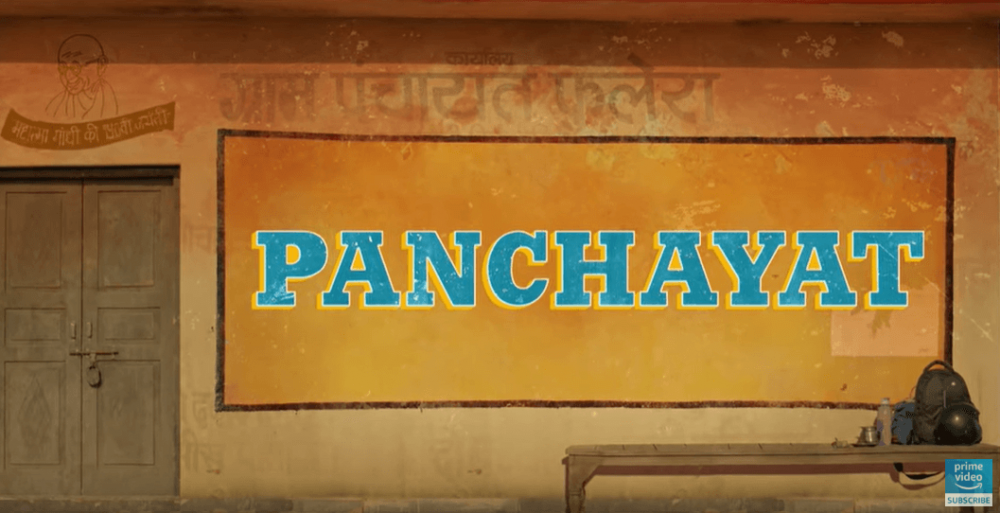Set in the backdrop of Phulera, a nondescript village in Ballia, Uttar Pradesh, Panchayat is a sharp commentary on the functioning of local governance in India. The storyline follows the travails of Abhishek Mishra, a frustrated lower-middle-class Delhite who reluctantly joins the village as the Panchayat Secretary, while aspiring for landing admission in the MBA program. In contrast to the cliched Bollywood productions, Panchayat presents a fairly accurate portrait of a remote Hindi-belt village, with all its quirks and problems. Hailing from the neighboring state of Bihar, the author couldn’t help but note the attention to details that make the show authentic.
The authenticity of Panchayat is, in no way, limited to the location setup, dialogues, and mannerism of characters. Panchayat’s plot also captures the sociological dynamic and the functioning of the state apparatus at the village level. With around 30 percent of the population living in poverty, the state of Uttar Pradesh presents a tough governance challenge for the policy-makers. With its low level of urbanization and modernization, traditional values and social arrangements prevail and regulate the village life. However, the imposition of a democratic polity over the traditional village setup has produced its own peculiar arrangement. The everyday interaction of citizens with the state at the ground level is one notable aspect of this dynamic. With its focus on local self-governance, Panchayat reveals the glaring shortcomings of the Indian state in tackling the challenges of destitution in all the Phuleras of the Hindi belt.
In fact, the so commonplace inefficiency of welfare schemes is visible in the very first tour of the outsider Secretary to the village. The village pond, presumably dug up under the MGNREGA scheme, is supposed to meet the needs of villagers. However, in the searing heat so characteristic of the northern plain, the pond lies devoid of water. This, however, doesn’t stop the de facto village headman from an open declaration of his intention to leverage the pond for the next electoral campaign. In another characteristic display of hubris that characterizes the governance in India, the panchayat decides to install the solar light, bought from the MPLADS fund, outside the village premise. While the stated reason for the decision won’t be revealed to avoid spoilers, the political imperative of gathering votes by wasteful use of taxpayer-funded schemes is all too clear here as well. Sadly for us, the wastage of funds in terms of unviable asset creation is an endemic feature of schemes like MGNREGA.
A 2009 NCAER-PIF report, for instance, outlines the poor quality of assets generated under the MGNREGA:
“A lot of money was spent on digging ponds without conceptualizing factors like catchment area, sources of recharging, technical sanctions, and preparation of detailed estimates. Assets created in Karnataka were not according to specification and quantities executed were not as per the technical sanction.”
Additionally, MGNREGA is also plagued by leakages and creates distortion in the labor market. The issue of addressing the twin goals of asset creation and poverty reduction, however, remains a pertinent challenge. In this regard, direct cash transfer to the poor has been suggested as an alternative mechanism. Economists Jagdish Bhagwati and Arvind Panagariya have argued that it would free the labor to engage in other private productive activity; curb usurpation of funds by bureaucrats and politicians; enable the proper functioning of the rural labor market; help consolidate the fiscal status.
In another instance of malfeasance in the Panchayat, the public representatives, the headmen and the ward members, consensually decide to install solar lights in front of their own houses. The use of public office for private gain, in simple terms, amounts to corruption. In a federal polity, the logic of devolving power to the local level is clear in terms of dispersed knowledge in society and efficiency gain contingent upon local participation. However, the challenge of ensuring accountability couldn’t be sufficiently addressed only by a periodic plebiscite every five years. Apart from the more genuine devolution of power from the state capitals to village panchayats, what is needed is also active civic participation in the decision-making process. Achieving such attitudinal change won’t be as challenging as it seems, given the long history of social movements and protest mobilizations in the Indian republic.
It is not just the corruption in public office that turns the Indian state into the everyday villain for its people. The overstretched state, both inefficient and absent at the same time, also seeks to play the role of a moral reformer for the society. Perhaps, no single program illustrates the state paternalism better than the family planning scheme. The horrors of the coercive sterilization drive during the Emergency years showed the brutal state power in action. The brutality now has been replaced by a more nudge-like approach. Now, the scheme entails awareness programs in which funds are spent on deploying public buildings as the avenue to lecture the citizens on the virtue of having only 2 bachhe. In Panchayat, the awareness campaign creates quite a stir, courtesy an inane slogan. A quintessential product of the fertile bureaucratic imagination, the slogan seeks to shame people into having fewer children. Instead, the Phulera residents take offense at the bureaucratic affront to their dignity and remind the headmen of their ability to unseat him from the power.
In taking a planned top-down view, the politics of population control in India ignores the crucial insight from Development economics. Researches have shown that the decline in fertility rate is associated with the level of economic development (women education, women labor force participation, economic growth, etc) in a country. Therefore, a better population control strategy would be the adoption of policies that empower women and create enough good jobs in the economy. Shaming people into producing fewer children doesn’t exactly amount to sound public policy. Rather, the provision of public goods and fostering of an entrepreneurial economy would automatically lead to people having fewer children along with improved living standards.
The quirks of Panchayat aren’t just limited to public policy but also covers the hullabaloo of everyday politics as practiced in the cow belt. In a democratic setup, politicians are seen as representatives of the electorate and derive legitimacy from meeting their aspirations. But, in practice, the power that comes with the elected office often tends to breed arrogance and corruption. As a result, argues Princeton economist Atul Kohli, Indian polity has come to resemble a ‘two-track democracy’ where common people are only needed at the time of elections while politicians run the show in collusion with special interest groups. In Panchayat, the arrogance bred by power mixes with a deep-seated sensibility of hierarchy, bolstered by the discourse shaped by a small coterie colloquially known as the chamchas. The prop here is a seemingly harmless rolling chair which comes to reveal the steadfast adherence to hierarchy in government offices. As the Village Secretary brings to himself the comfort of a new rolling chair in the otherwise nondescript office, Pradhan jee takes it as an affront to his power in the office, manifested in the now inferior chair of his. The power balance over the chair gets restored by the end of the episode, but not without raising pressing questions on the absurdity of hierarchy in government offices.
The perverted functioning of power also has a gendered dimension which has been captured by the show. In a bid to enable women’s representation in rural self- governance institutions, the Indian state has made the provision for reservation of seats for women in panchayats. In a comical twist, it has led to the creation of a new post of so-called MPs at the village level. The Mukhiya Pati phenomenon is so entrenched in the cow belt that even a World Bank report took note of it. In Phulera, Brij Bhushan is the de facto headmen while his wife, the elected headmen, limits herself to the boundaries of homemaking. Even though Panchayat never comes out as a moral sermon on everything that is wrong with rural India, it attempts to redeem the village in a heroic attempt. Towards the climax of the series, the actual Pradhan Manju Devi steps out of the Bhushan household to honor her commitment as an elected representative. And, it is here that the show falters. Ironically for the show that reveals state failures in the cow belt hinterland, it ultimately succumbs to the bureaucratic savior complex. For the untutored citizens of Phulera, it takes a surprise visit from a strict District Magistrate to set things in order. While the heroic deeds of individual bureaucrats indeed sometimes bring the change, it is no compensation for the systematic failure that the Indian state is. Ensconced in their privileged cocoon looking down upon and humiliating the disadvantaged, bureaucrats often tend to be part of the problem, not the solution.
A fine work of storytelling that Panchayat is, it also accurately captures the social dynamic of the surroundings that it is set in. Watch the show for its gripping storytelling and realistic depiction of rural India.
Read more: Uncertain Lives: How Street Vendors Earn, Spend and Borrow- Part 1
Post Disclaimer
The opinions expressed in this essay are those of the authors. They do not purport to reflect the opinions or views of CCS.






